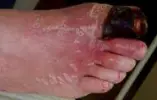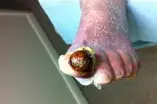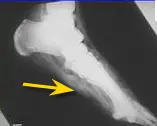gangrene
AUTHOR: Marc Mitnick DPM home --> gangreneWHAT IS GANGRENE
Gangrene is the death of tissue due to an interruption of blood flow to that particular area of the body. The condition primarily affects the extremities with the toes being more susceptible than the fingers. It is important to note that you can also have tissue death of the muscles and internal organs as well, but this discussion will be directed toward the toes and feet.
Causes of gangrene include the following:
Risk factors involved in gangrene include:
- age older individuals are more prone to this condition.
- Diabetes can cause tissue death because if your blood sugars are not adequately controlled, the elevated blood sugars eventually damage the blood vessels that supply blood to the feet and toes and cuts off the circulation.
- Arteriosclerosis or hardening of the arteries may also end up blocking blood flow into the toes.
- blue toe syndrome a blood clot into the foot could cause diminished blood flow to the toes.
- Injury including surgery, which traumatizes the skin and underlying tissue may cut off circulation creating lack of circulation to the tissue.
One of the protocols in foot surgery is to always make sure there is enough distance between two incisions so that the skin in between does not have its circulation cut off and thus die.
- exposure to severe cold (frostbite) which can cause tissue death because extreme cold clamps closed the small vessels going into the toes.
- Immunosuppression may also cause tissue death because immuno-compromised patients have a higher risk of developing infection which then cuts off circulation.
Signs and symptoms of tissue death as it affects the toes
- black or blue discoloration of the skin. Sometimes if there has been trauma to a toe, the black or blue discoloration may be nothing more than dry blood, but it is important for a doctor to check the toe to make sure it is only dry blood.
- severe pain at the end of the toe
- feeling of numbness
- the toe may also be swollen
- drainage coming from the toe
- odor which would indicate the area is probably infected
- Many people will also develop a fever and will have a feeling of not being well.
TYPES OF GANGRENE
Tissue death comes in different forms
Dry gangrene is characterized by dry leathery type skin which is usually purplish to black in color. It is seen more in people who have hardening of the arteries. Generally, this type is not infected. In the picture below you can see the distinct demarcation of healthy vs. unhealthy tissue on the great toe. This black area is completely dry and has a leathery texture to it.

|
Wet Gangrene means that there is a bacterial infection. It is characterized by swelling, drainage, and possible blistering. This is considered a medical emergency and needs to be treated immediately because these infections can spread rapidly. Looking at the picture to the right you will see that it looks similar to the above picture, but it is not. This toe is actively draining exudate (pus) and there is an opening in the toe leading to deeper tissue.

|
Gas gangrene affects deep muscle tissue that has been deprived of its blood supply either by surgery or trauma. This will occur more in the foot rather than the toes. When the blood supply is cut off to a muscle, a bacteria, Clostridium perfringens, produces a toxin which creates gas under the skin. This will eventually cause tissue death. This is also considered a medical emergency as these infections can also spread very quickly. If you look at the xray below, note the yellow arrow. It is pointing to a cloudy area in the xray which is the gas that is produced from the infection.

|
TREATMENT OF GANGRENE
As just stated, wet and gas variety are medical emergencies and require immediate care. The dry version also requires medical attention but is usually not an acute emergency but can certainly worsen if not properly treated. In many cases of dry gangrene, particularly in parts of the world not readily accessible to medical care, the dead tissue may just slough off (autoamputation). If the patient is lucky and the area does not get infected the area may heal on its own.
The other two types of gangrene are treated much more aggressively. Untreated gangrene of the wet and gas variety will lead to a worsening of the associated sepsis which can lead to death.
Usually there will be a surgical procedure to remove the "dead" tissue. The surgeon will need to determine the demarcation between where there is no circulation and adequate circulation and the removal of tissue will take place at that junction. If gangrene of a toe is just a symptom of very poor circulation in the leg such as in a diabetic, then an amputation further up the foot or leg may be necessary.
In addition intravenous antibiotics will be administered to clear up any infection. This will all require a hospital stay. Some institutions have begun treating this condition with hyperbaric oxygen which is high pressure oxygen that is delivered to an oxygen deprived area (such as the foot with poor circulation) in an effort to re-introduce oxygen into the tissues that are otherwise not getting enough oxygen due to poor circulation. The idea here is two-fold. One is to give the tissue the oxygen it needs to heal itself and the other is to kill some bacteria known as anaerobic bacteria which thrive in an environment where there is low oxygen tension.
Like most medical conditions, the best way to treat this condition is through prevention.
- avoiding tobacco, which clamps closed your blood vessels is a must.
- Avoiding exposure to cold
- Diabetics need to closely monitor their blood sugars with their doctor in an effort to keep them as close to normal as possible.
- Many diabetics suffer from neuropathy and so it is important they have regular foot exams to make sure there are no problems developing on their feet. If there is a wound that occurs for whatever reason, the patient should see their doctor immediately for proper treatment in an effort to avoid infection.
REFERENCES
Want more information? CLICK HERE


Recent Articles
-
Vitamin D impact on health
Feb 06, 23 07:17 PM
Researchers are suggesting that the effectiveness of Vitamin D in fighting and preventing disease is predicated on a persons body mass index (BMI). The thinner the person the greater the positive impa… -
Foods to speed up healing
Feb 01, 23 02:41 PM
One of the best ways to help yourself heal faster after surgery is to eat well. Getting the proper nutrition will provide your body with the essentials it needs to promote healing. Here is a suggestio… -
Cancer and Type 2 Diabetes
Jan 25, 23 04:52 PM
An article revealing that older type 2 diabetics have a higher incidence of cancer then non-diabetics. It is suggested that cancer may surpass CVD as the number one cause of death in older diabetics. -
Does glucosamine or MSM reduce arthritis pain?
Jan 22, 23 01:41 PM
A good review of the possible benefits to taking glucosamine, chondroitin or MSM for arthritis. Always beware of the possible side effects of over the counter supplements. -
shin splints
Jan 18, 23 05:12 PM
A great review on the various causes of shin splints, along with treatment options. -
Whats new in skin cancer?
Jan 15, 23 08:32 PM
A presentation of newer skin protection combinations in an effort to better protect the skin from the hazards of sun exposure. -
Causes and risk factors of warts
Jan 14, 23 05:02 PM
A good review of the causes of warts and protective measures you can take to prevent developing them. -
Do chronic wounds need to be dressed daily?
Jan 11, 23 02:18 PM
Because of supply chain shortages as well as staffing shortages particularly during the pandemic, many institutions extended the time between dressing changes for chronic wounds. Is this really the be… -
Food choices that raise your risk of type 2 diabetes
Jan 08, 23 10:07 AM
A good review of how blood sugars can become elevated and the harm that can do. Certain food groups have a tendency to raise your blood sugars and should be avoided. -
Outcome stats from Scarf bunionectomy
Jan 03, 23 03:04 PM
The Journal of Foot and Ankle Surgery recently reported a meta analysis of outcomes in 1583 Scarf bunionectomies that met their inclusion criteria. Adverse events did not seem to be any better or wors…